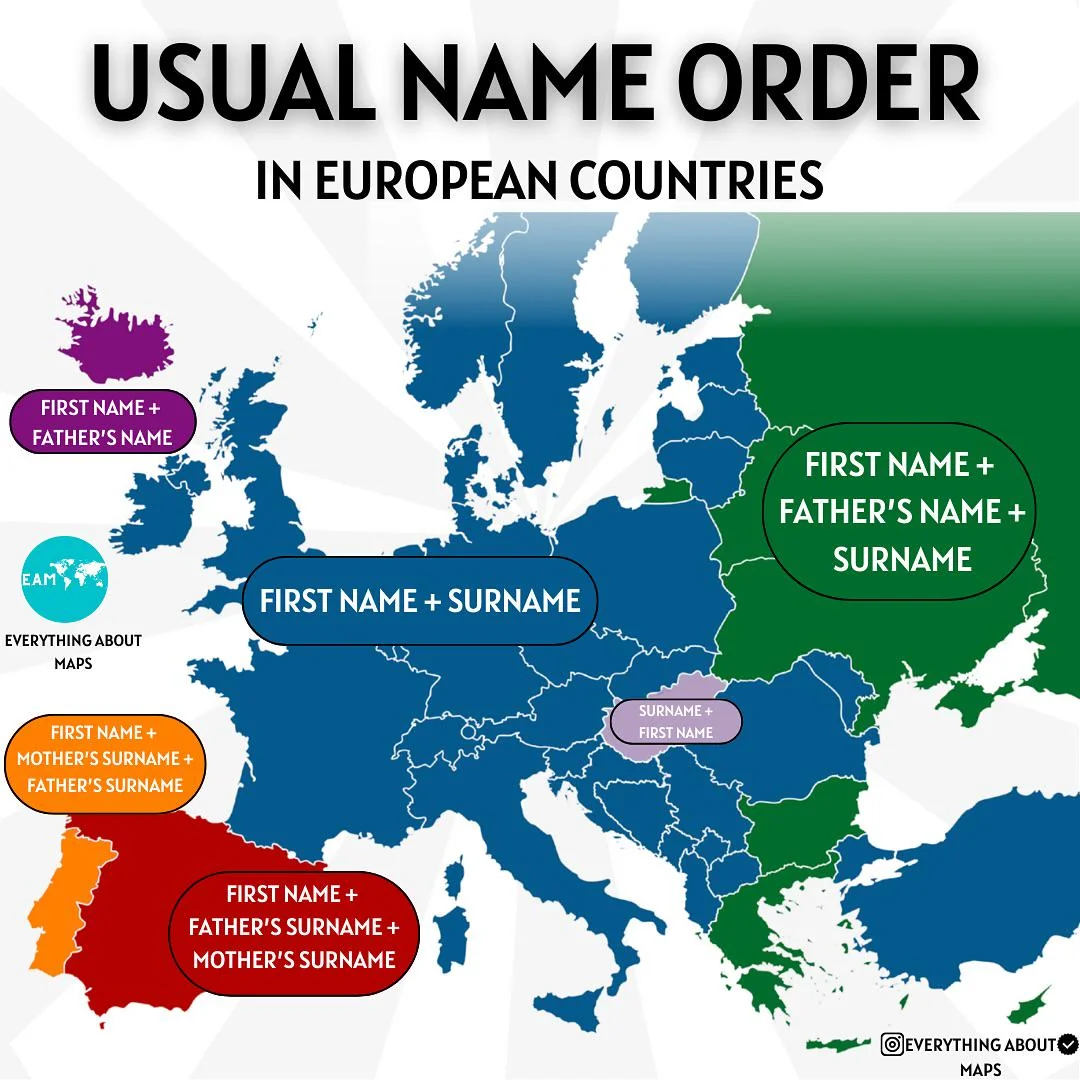Usual Name Order in European Countries Map


David Chen
Data Visualization Specialist
David Chen is an expert in transforming complex geographic datasets into compelling visual narratives. He combines his background in computer science ...
Geographic Analysis
What This Map Shows
This map illustrates the typical order of names as they appear in various European countries. In many cultures, the sequence of a person's name can reflect historical, familial, and social structures. For example, in some countries, surnames come first, while in others, the given name precedes the family name. Understanding these naming conventions is not just a matter of etiquette; it reflects deeper cultural identities and social norms.
Deep Dive into Name Order in Europe
The naming conventions across Europe can be quite diverse and are influenced by historical, linguistic, and cultural factors. In general, most Western European countries, such as the United Kingdom, France, and Germany, follow the given name followed by the surname order (e.g., John Smith). This format is straightforward and widely recognized in international contexts.
However, Eastern European countries often present a different perspective. For instance, in Hungary, the traditional order is reversed, where the surname precedes the given name (e.g., Smith John). This naming order is deeply rooted in Hungarian culture and can be traced back to historical practices that emphasize family lineage and heritage.
Interestingly, some cultures incorporate middle names or patronymics, which are derived from the father's name. In countries like Iceland, this practice is prevalent, where the last name might reflect the first name of a parent, followed by the suffix '-son' for sons and '-dóttir' for daughters (e.g., Jónsson for a son of Jón and Jónsdóttir for a daughter).
In Scandinavia, similar naming conventions exist, although often less rigidly adhered to. In Denmark and Norway, names are also typically structured as given name followed by surname, but the influence of patronymics remains a fascinating aspect of their naming traditions.
The use of multiple names is also significant in many cultures. For example, in Spain and many Latin American countries, it’s common to have two family names (e.g., Maria Garcia Lopez). This practice is a reflection of the importance of both paternal and maternal lineage in these cultures. When these individuals are represented in international contexts, the order can sometimes lead to confusion if not properly understood.
Regional Analysis
When examining the map more closely, we can see that Western Europe predominantly follows the given name-surname order. Countries like France, Germany, and the Netherlands maintain this structure, resulting in a cohesive understanding of personal identification within legal and social frameworks.
In Central and Eastern Europe, however, variations become apparent. Slovenia and Croatia also tend to favor the given name-surname format, but Hungary diverges with its surname-first convention. This difference is significant, especially when considering cross-border interactions and official documentation where name order can impact identity verification.
The Nordic countries present an interesting case study as well. While they largely follow the Western naming order, the historical patronymic system adds layers to individual identities. For instance, in Sweden, one might encounter individuals with surnames derived from their father's name, such as Andersson (son of Anders) and Johansson (son of Johan), which showcases both lineage and personal identity.
Southern Europe, particularly Spain and Portugal, emphasizes the dual surname system, reflecting a blend of paternal and maternal heritage. This presents unique challenges in international contexts where name order and recognition may differ from local customs.
Significance and Impact
Understanding naming conventions in Europe is crucial for multiple reasons. Firstly, it aids in fostering respectful communication in both personal and professional contexts. Ever wondered why names can sometimes be mispronounced or misrepresented? It's often due to a lack of awareness of these conventions.
Moreover, in an increasingly globalized world, recognizing the importance of name order can enhance cross-cultural interactions, support diversity, and promote inclusivity. As societies become more interconnected, awareness of such nuances can help bridge cultural divides.
Current trends show a growing interest in cultural heritage, leading to a revival of traditional naming practices. As people seek to connect with their ancestry, understanding these naming conventions will become even more relevant. Future projections suggest that as global migration increases, we may witness an even richer tapestry of naming practices, further emphasizing the need for cultural sensitivity.
In conclusion, the usual name order in European countries is more than just a naming preference; it is a window into the cultural, historical, and social fabric of each society. Whether you're traveling, working, or simply engaging with individuals from different backgrounds, being mindful of these conventions can make a significant difference in your interactions.
Visualization Details
- Published
- October 29, 2025
- Views
- 10
Comments
Loading comments...